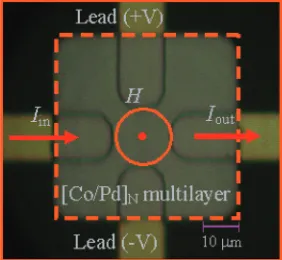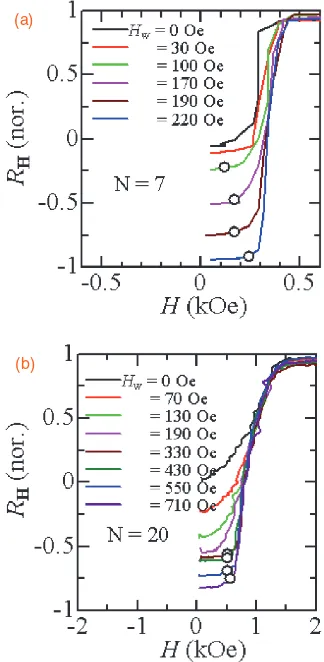Material Dependence of Thermally Assisted Magnetization Reversal Properties
in Microstructured Co/Pd Multilayers
Budi Purnama, Terumitsu Tanaka, Yukio Nozaki, and Kimihide Matsuyama Department of Electronics, Kyushu University, 744 Motooka, Nishi-ku, Fukuoka 819-0395, Japan
Received December 5, 2008; accepted February 1, 2009; published online February 20, 2009
Using extraordinary Hall resistance (RH) measurements, the material dependence of thermally assisted magnetization reversal (TAMR)
was investigated for microstructured multilayers of [Co (0.17 nm)/Pd (0.80 nm)]N with N¼7and 20, which exhibit markedly different magnetic properties. The threshold values of the external field (Hw,th) necessary for controlling the magnetization direction in TAMR,
obtained by direct application of a current pulse to the sample, were 220 Oe for theN¼7and 710 Oe forN¼20samples. The values of Hw,thare found to be related to the magnetization saturation field at a critical temperature at which apparent coercivity decays.
#2009 The Japan Society of Applied Physics
DOI:10.1143/APEX.2.033001
M
agnetoresistive random access memory (MRAM)is expected to be a universal memory that satisfies the demands for high bit density, fast access time and practically unlimited durability. Thermally assisted magnetization reversal (TAMR) has been proposed for application in MRAM1–6)as a promising approach to realize the maximum possible bit density using high perpendicular magnetic anisotropy (PMA) materials, as already demon-strated in hard disc drive (HDD) technology. Since the magnetization reversal in MRAM is performed with current-induced local magnetic fields, reduction of the reversal field is essential for low-power memory operation. Unlike conventional magnetization reversal, TAMR is a field-induced magnetic ordering process under significant thermal disturbance. Thus, a threshold value of the external field (Hw,th) to define the final magnetization direction and its dependence on the material parameters are important for material optimization and the prospects for scaling in thermally assisted MRAM (TA-MRAM). Among the various PMA materials available, Co/Pd multilayers exhibit a wide variety of magnetic properties, including variation in the strength of PMA and its temperature dependence, which can be controlled by varying the individual layer thickness, layer repetition number, and deposition conditions.7,8) A
correlation between the Hw,th and the strength of PMA, reflected in the coercivity, was predicted in micromagnetic simulations.9) The present work compares TAMR perfor-mance in microstructured Co/Pd films with different magnetic properties.
Co/Pd multilayers were deposited on glass substrates by tandem-type magnetron sputtering with a multi-cathode system (Anelva SPC-350). Background pressure was below 5:010 7Torr, and Ar pressure during deposition was
fixed at 20 mTorr. The substrate was mounted on a sample holder and rotated at 50 rpm around the Co and Pd targets using a PC-controlled shutter system. The sputtering rates for Co and Pd were 0.10 and 0.036 nm/s, respectively. Microstructured Co/Pd multilayers with a lateral size of 5050m2
were fabricated by photolithography and followed by a lift-off process. Two pairs of 10-m-wide underlie electrodes of Ti (20 nm)/Au (100 nm), used for Joule heating and extraordinary Hall resistance (RH) measurements, were fabricated at each edge of the Co/Pd pattern as shown in Fig. 1. In the TAMR experiments, the sample temperature was raised by applying a current pulse to the Co/Pd pattern through one pair of electrodes with a fast
pulse generator. The sample resistance was matched to a coaxial cable impedance of 50 with an additional series resistance. A pulse width of 300 ns was chosen, so that the entire structure could attain a thermal stationary state,10)as was evidenced from the pulse width dependence of TAMR properties. The magnetization reversal behavior was in-vestigated by measuring RH, which is related to the perpendicular magnetization.11) The RH hysteresis for the
perpendicular field sweep was also measured at various temperatures with a Cu heat block system. Among the fabricated samples, [Co (0.17 nm)/Pd (0.80 nm)]N with N¼7 and 20, referred to N7 and N20 hereafter, are the focus of the present study since they exhibit significantly different coercivity, which is related to the strength of PMA. Figure 2 shows RH hysteresis curves for N7 and N20, measured at various temperatures. The plottedRHvalues are normalized with that measured at a room temperature (RT) of 23C. As can be seen in the figure, superior squareness
and remanence are realized for the N7 up to 90C,
suggesting that the nucleation-type magnetization reversal is dominant at elevated temperatures. In contrast, a gradual increase of RH without hysteresis is observed at 120C, which can be attributed to the enhanced thermal fluctuation effect. Another critical change in the RH behavior is
observed at 190C for the sample N20, as shown in
Fig. 2(b). The observed hysteresis-free RH curve with a notable knee is typical of that measured along the effective hard axis direction, which can be explained as follows. The net uniaxial perpendicular anisotropy Ku is a summation of the surface anisotropy (2Ks=tCo) and the volume anisotropy Fig. 1. Schematic top view of microstructured Co/Pd multilayers for TAMR experiments.
Applied Physics Express2(2009) 033001
(Kv) including the shape anisotropy term.12) Accordingly, the apparent transition of the effective easy axis direction from perpendicular to in-plane can be caused by the compensation of opposite contributions from Ks and Kv with different temperature dependences. Magnetization reversal is triggered at the nucleation field Hn and is succeeded by wall motion until being practically saturated at Hs, as shown in the figure. The significant difference
between Hn and Hs in the case of N20 indicates the
significant distribution of intrinsic PMA.13,14)
Temperature dependences of the coercive fieldHcand the saturation fieldHs for N7 and N20 are compared in Fig. 3. Hcdecreases with the increasing temperature, and decays at a critical temperatures (Tcrt) of 100C for N7 and 190C for N20. The thermally demagnetized temperatures, estimated from the temperature dependence ofRH, are 140C for N7 and 220C for N20, respectively. Hs also decreases with increasing temperature. The different magnetization reversal modes for the two samples are demonstrated in the mostly coincident (N7) and different (N20) values ofHcandHsfor T < Tcrt.
Dynamic TAMR properties have also been investigated by Joule heating with a pulsed conductor current. The experimental procedure is as follows. First the magnetization of the Co/Pd was saturated with a perpendicular field of 4.0 kOe. Thereafter, a current pulse was directly applied through the Co/Pd pattern under various perpendicular fields of Hw. The current amplitude was adjusted so that the
normalized RH after Joule heating becomes zero at
Hw¼0Oe, indicating thermal demagnetization. The power densities (p) required for thermal demagnetization are evaluated from the current amplitude as 0.19 mW/m2 (N7) and 0.71 mW/m2(N20). The different values ofpcan be related to theTcrtof the two samples.
The values of RH measured after the above TAMR
procedure are shown in Fig. 4 as a function of Hw. RH
decreases with increasing Hw and approaches to the
saturation value of about 1 at a threshold field, indicated as Hw,th in the figure. Hw,th is related to the field strength required to sweep away the domain wall during the field cooling process from the thermally induced demagnetized state. The values ofHw,th are 220 Oe for N7 and 710 Oe for N20. These values appear to be correlated with the Hs at raised temperatures, as shown in Fig. 3. The TAMR occurs during the 300-ns-wide current pulse, which is of the order of 10 8
shorter than that for the RH hysteresis measure-ments (30s). Accordingly, the larger value of Hw,th compared with thermally reduced Hs can be attributed to
the time dependence of the magnetization reversal
field.15) The marked tail of the RH–Hw curve for the N20 sample corresponds to the degraded squareness of Fig. 3. The temperature dependence of coercive field, Hc and
practical saturated field, Hs for [Co (0.17 nm)/Pd (0.80 nm)]N with
N¼7and 20.
Fig. 4. Extraordinary Hall resistance (RH) measured after
performing TAMR with various external fields (Hw).
(a)
(b)
Fig. 2. Hysteresis of extraordinary Hall resistance (RH) for external
field (H) sweep, measured at various temperatures for [Co (0.17 nm)/ Pd (0.80 nm)]Nwith (a)N¼7and (b)N¼20.
B. Purnamaet al.
Appl. Phys. Express2(2009) 033001
the RH–H hysteresis, as shown in Fig. 2(b). The gradual decrease of RH for the N7 sample indicates the stochastic aspect of the wall depinning process in imperfect TAMR, as discussed in the following paragraph. The reduction rate of the field required by the TAMR, defined as [ðHsðat 23CÞ Hw,thÞ=Hsðat 23CÞ], is comparable be-tween the two samples; 0.50 for N7 and 0.43 for N20.
To further study TAMR behaviors the evolution ofRHfor the integrating field sweep was measured after performing TAMR with various Hw, as shown in Fig. 5. The different RH–H curves for the two samples also demonstrate the different TAMR properties, originating from individual magnetic characteristics. The rising edge, marked with open circles in theRH–Hcurve, indicates the wall depinning field, which increases with increase in Hw and lies closes to the nucleation field, as shown in the figure. This result implies that the domain walls remaining after the imperfect TAMR
are trapped at the energy wells, which cannot be
over-whelmed by Hw within the cooling time. The gradual
increase of RH for the N20 sample measured at Hw lower than 190 Oe, indicates broad variation in the strength of the wall-trapping energy well. The appearance of the rising edge in theRH–Hcurves, notable at Hw larger than 260 Oe, can be explained by the removal of the domain walls with a depinning field smaller than the nucleation field during the TAMR process.
In summary, the material dependence of TAMR behavior has been investigated for microstructured [Co (0.17 nm)/ Pd (0.80 nm)]N patterns with N¼7 and 20 using extra-ordinary Hall effect measurements. Current-induced dy-namic Joule heating up to a critical temperature results in about 50% reduction of the reversal field compared with that measured at RT. The threshold value of the external field (Hw,th) required for controlling the magnetization direction in TAMR was found to be related to the thermally reduced saturation field. That is, the measured Hw,th is 220 Oe for N¼7 and 710 Oe for N¼20. Thus, an optimum design considering for the bit information stability and the magnetization reversal field would be still essential in the TA-MRAM scheme. Further reduction of the reversal field is expected for practical MRAM elements of an order 100 nm or smaller due to the lower demagnetization factor.
1) R. S. Beech, J. A. Anderson, A. V. Pohm, and J. M. Daughton:J. Appl. Phys.87(2000) 6403.
2) Z.-H. Wu, S.-H. Lai, S.-H. Huang, and W.-C. Lin:J. Magn. Magn. Mater.304(2006) 93.
3) I. L. Prejbeanu, M. Kerekes, R. C. Sousa, O. Redon, B. Dieny, and J. P. Nozieres:J. Phys.: Condens. Matter19(2007) 165218. 4) Z.-Y. Liu, G.-C. Han, and Y.-K. Zheng:IEEE Trans. Magn.40(2004)
2622.
5) L. You, T. Kato, S. Tsunashima, and S. Iwata:Jpn. J. Appl. Phys.47
(2008) 146.
6) K.-J. Kim, J.-C. Lee, S.-B. Choe, and K.-H. Shin:Appl. Phys. Lett.92
(2008) 192509.
7) S. Hashimoto, Y. Ochiai, and K. Aso:J. Appl. Phys.66(1989) 4909. 8) B. Purnama, Y. Nozaki, and K. Matsuyama: Dig. Intermag. 2008,
HU-08.
9) B. Purnama, Y. Nozaki, and K. Matsuyama:J. Magn. Magn. Mater.
310(2007) 2683.
10) R. C. Sousa, M. Kerekes, I. L. Prejbeanu, O. Redon, B. Dieny, J. P. Nozieres, and P. P. Freitas:J. Appl. Phys.99(2006) 08N904. 11) S. Kim, S. R. Lee, and J. D. Chung:J. Appl. Phys.73(1993) 6344. 12) F. J. A. den Broeder, H. C. Donkersloot, H. J. G. Draaisma, and
W. J. M. de Jonge:J. Appl. Phys.61(1987) 4317.
13) J. W. Lau, R. D. Mcmichael, S. H. Chung, J. O. Rantschler, V. Parekh, and D. Litvinov:Appl. Phys. Lett.92(2008) 012506.
14) E. Chunsheng, V. Parekh, P. Ruchhoeft, S. Khizroev, and D. Litvinov:
J. Appl. Phys.103(2008) 063904.
15) C. S. Brown, J. W. Harrell, and S. Matsunuma:J. Appl. Phys.100
(2006) 053910.
(a)
(b)
Fig. 5. Extraordinary Hall resistance (RH) changes with additional
field sweep; measured after performing TAMR under various external fields (Hw).
B. Purnamaet al.
Appl. Phys. Express2(2009) 033001

![Fig. 3.The temperature dependence of coercive field, Hc andpractical saturated field, Hs for [Co (0.17 nm)/Pd (0.80 nm)]N withN ¼ 7 and 20.](https://thumb-ap.123doks.com/thumbv2/123dok/1001571.490677/2.595.342.508.308.475/temperature-dependence-coercive-field-andpractical-saturated-field-withn.webp)
